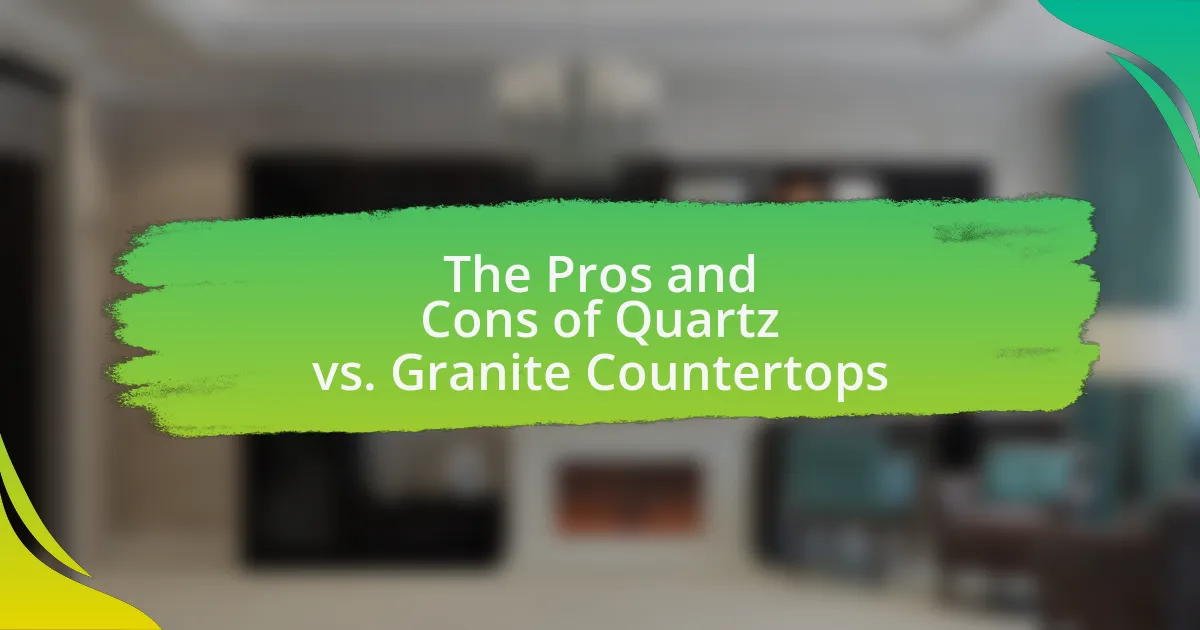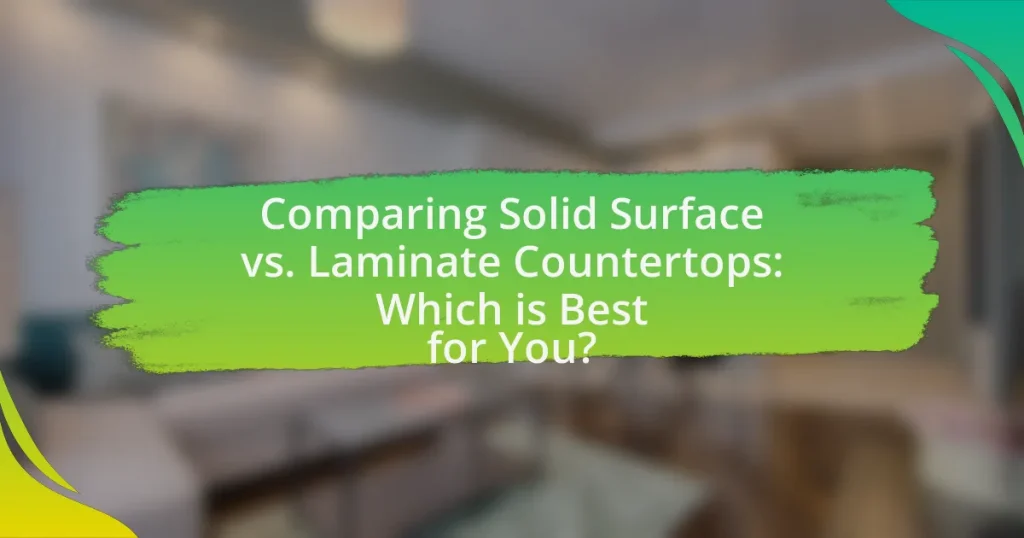The article examines the pros and cons of quartz and granite countertops, two popular materials for kitchen and bathroom surfaces. It provides a detailed comparison of their composition, durability, maintenance requirements, aesthetic appeal, and cost. Key differences include quartz’s engineered nature, which offers a non-porous surface resistant to stains and scratches, versus granite’s natural stone characteristics that provide unique patterns but require regular sealing. The article also discusses the primary uses of both materials, their advantages and disadvantages, and practical considerations for homeowners when choosing between them.
What are Quartz and Granite Countertops?

Quartz and granite countertops are popular materials used in kitchen and bathroom surfaces. Quartz countertops are engineered stone products made from approximately 90-95% crushed natural quartz crystals mixed with resins and pigments, resulting in a non-porous, durable surface. Granite countertops, on the other hand, are natural stone products formed from cooled magma, consisting primarily of quartz, feldspar, and mica, which gives them unique patterns and colors. Both materials are valued for their aesthetic appeal and durability, with granite being heat and scratch-resistant, while quartz offers a wider range of colors and patterns due to its manufacturing process.
How do Quartz and Granite differ in composition?
Quartz is a mineral composed primarily of silicon dioxide (SiO2), while granite is an igneous rock that consists of a mixture of minerals, predominantly quartz, feldspar, and mica. The composition of quartz is uniform, consisting almost entirely of silicon dioxide, whereas granite has a more complex composition with varying proportions of its constituent minerals, typically around 20-60% quartz, 10-65% feldspar, and 5-15% mica. This difference in composition affects their physical properties, durability, and appearance, making quartz a more consistent material and granite more variable in texture and color.
What materials are used to create Quartz countertops?
Quartz countertops are primarily made from a mixture of approximately 90-95% crushed natural quartz crystals and 5-10% resins, polymers, and pigments. This combination results in a durable and non-porous surface that is resistant to stains and scratches. The use of natural quartz, which is one of the hardest minerals, contributes to the strength and longevity of the countertops, while the resins and pigments allow for a wide variety of colors and patterns, enhancing aesthetic appeal.
What natural elements make up Granite countertops?
Granite countertops are primarily composed of natural elements such as quartz, feldspar, and mica. These minerals contribute to the durability and aesthetic appeal of granite, with quartz making up about 20-60% of the composition, feldspar around 30-50%, and mica typically comprising 5-10%. This mineral combination results in the unique patterns and colors found in granite, making it a popular choice for countertops.
What are the primary uses of Quartz and Granite countertops?
Quartz and granite countertops are primarily used in kitchen and bathroom applications due to their durability and aesthetic appeal. These materials are favored for their resistance to scratches, heat, and stains, making them ideal for high-traffic areas. Additionally, quartz countertops are non-porous, which prevents bacterial growth, while granite offers a unique natural stone appearance that enhances the visual appeal of spaces. Their longevity and low maintenance requirements further solidify their popularity in residential and commercial settings.
In which settings are Quartz countertops most commonly found?
Quartz countertops are most commonly found in residential kitchens and bathrooms. These surfaces are favored for their durability, low maintenance, and aesthetic appeal, making them ideal for high-traffic areas where both functionality and design are important. Additionally, quartz countertops are increasingly used in commercial settings such as restaurants and offices due to their resistance to stains and scratches, which enhances their longevity and performance in busy environments.
What types of projects typically utilize Granite countertops?
Granite countertops are typically utilized in residential kitchen renovations, bathroom remodels, and commercial spaces such as restaurants and hotels. These projects benefit from granite’s durability, aesthetic appeal, and resistance to heat and scratches, making it a preferred choice for surfaces that experience heavy use. The National Kitchen and Bath Association reports that granite is one of the most popular materials for countertops, highlighting its widespread acceptance in both new constructions and renovations.
What are the Advantages of Quartz Countertops?

Quartz countertops offer several advantages, including durability, low maintenance, and aesthetic versatility. They are engineered from natural quartz crystals and resins, making them non-porous and resistant to stains, scratches, and heat. This durability ensures that quartz countertops can withstand daily wear and tear, making them ideal for high-traffic areas in kitchens and bathrooms. Additionally, their non-porous nature prevents the growth of bacteria and mold, contributing to a hygienic surface.
Moreover, quartz countertops come in a wide range of colors and patterns, allowing for customization to fit various design preferences. This aesthetic flexibility is supported by the fact that manufacturers can produce quartz surfaces that mimic the appearance of natural stone, providing the beauty of granite or marble without the associated maintenance challenges. Overall, the combination of durability, low maintenance, and design options makes quartz countertops a popular choice among homeowners and designers alike.
How does durability compare to Granite?
Quartz countertops generally offer comparable durability to granite, but with some distinctions. While both materials are highly resistant to scratches and heat, quartz is engineered with resins that make it less porous than granite, resulting in improved resistance to stains and bacteria. Granite, being a natural stone, can be more susceptible to chipping and requires periodic sealing to maintain its resistance to stains. Studies indicate that quartz surfaces can withstand impacts better than granite, making them less likely to crack under heavy use.
What factors contribute to the durability of Quartz countertops?
The durability of Quartz countertops is primarily attributed to their non-porous nature, high resistance to scratches, and the use of resin in their composition. Quartz countertops are engineered from approximately 90-95% crushed natural quartz crystals combined with resins and polymers, which enhances their strength and makes them less susceptible to staining and damage compared to natural stones. This engineered process results in a surface that can withstand heat and impact better than many other materials, ensuring longevity. Additionally, the non-porous characteristic prevents the absorption of liquids, reducing the risk of bacterial growth and staining, which further contributes to their durability.
How resistant are Quartz countertops to scratches and stains?
Quartz countertops are highly resistant to scratches and stains due to their non-porous surface and durability. The composition of quartz, which includes about 90-95% crushed natural stone combined with resins, creates a robust material that withstands everyday wear and tear. Additionally, the non-porous nature prevents liquids from penetrating, making it less likely to stain compared to other materials like granite. This resistance is supported by the fact that quartz countertops are often rated highly for their durability in kitchen and bathroom environments, where exposure to potential staining agents is common.
What aesthetic benefits do Quartz countertops offer?
Quartz countertops offer a wide range of aesthetic benefits, including a uniform appearance and a variety of colors and patterns. The engineered nature of quartz allows for consistent coloration and design, which can create a sleek and modern look in any kitchen or bathroom. Additionally, quartz can mimic the appearance of natural stone, providing the beauty of materials like marble or granite without the maintenance issues. The non-porous surface of quartz also contributes to its aesthetic appeal, as it resists staining and does not require sealing, maintaining its visual integrity over time.
How does the variety of colors and patterns in Quartz enhance design?
The variety of colors and patterns in Quartz enhances design by providing versatility and aesthetic appeal in various applications. This extensive range allows designers and homeowners to select options that complement their specific style and environment, making Quartz suitable for both contemporary and traditional settings. For instance, Quartz can mimic the appearance of natural stones while offering a more uniform look, which is often preferred in modern designs. Additionally, the ability to customize colors and patterns means that Quartz can be tailored to fit unique design themes, ensuring that it meets the specific visual requirements of any project.
What are the maintenance requirements for maintaining Quartz’s appearance?
To maintain Quartz’s appearance, regular cleaning with mild soap and water is essential. This prevents the buildup of dirt and grime that can dull its surface. Additionally, avoiding harsh chemicals and abrasive cleaners is crucial, as they can damage the finish. It is also recommended to use cutting boards and trivets to protect the surface from scratches and heat damage. Regularly sealing is not necessary for Quartz, as it is non-porous, but wiping up spills promptly helps maintain its aesthetic appeal. These practices ensure that Quartz retains its luster and durability over time.
What are the Advantages of Granite Countertops?

Granite countertops offer several advantages, including durability, aesthetic appeal, and resistance to heat and scratches. Their hardness makes them less prone to chipping and cracking compared to other materials, ensuring longevity in kitchen environments. Additionally, granite is available in a wide range of colors and patterns, allowing for customization that enhances the visual appeal of any space. Furthermore, granite’s non-porous surface, when properly sealed, resists stains and bacteria, making it a hygienic choice for food preparation areas. These characteristics contribute to granite’s popularity among homeowners and designers alike.
How does the natural beauty of Granite compare to Quartz?
Granite exhibits a natural beauty characterized by its unique patterns and colors, often featuring speckles and veining that result from its crystalline structure. In contrast, Quartz, being engineered, offers a more uniform appearance with a wider range of colors and patterns, but lacks the distinct natural variations found in Granite. The aesthetic appeal of Granite is often favored for its organic look, while Quartz is appreciated for its consistency and modern design options.
What unique patterns and colors can be found in Granite?
Granite exhibits a wide range of unique patterns and colors, including speckled, swirled, and veined designs. These variations arise from the mineral composition of granite, which typically includes quartz, feldspar, and mica, leading to colors such as pink, gray, black, and white. The specific arrangement and concentration of these minerals create distinct visual effects; for instance, high quartz content can result in a shimmering appearance, while feldspar can impart a pink hue. The geological processes involved in granite formation contribute to its diverse aesthetic, making each slab unique.
How does the natural stone aspect of Granite appeal to homeowners?
The natural stone aspect of granite appeals to homeowners due to its unique aesthetic, durability, and value. Granite offers a distinctive appearance with varied colors and patterns, making each slab one-of-a-kind, which enhances the visual appeal of kitchens and bathrooms. Additionally, granite is highly durable, resistant to scratches and heat, which makes it a practical choice for high-traffic areas. According to the National Association of Realtors, homes with granite countertops can sell for up to 10% more than those without, indicating that granite not only enhances the beauty of a home but also contributes to its market value.
What are the heat resistance properties of Granite?
Granite exhibits excellent heat resistance properties, capable of withstanding high temperatures without damage. Typically, granite can endure temperatures up to 1,200 degrees Fahrenheit (about 650 degrees Celsius) without cracking or discoloration. This durability makes granite a popular choice for kitchen countertops, where exposure to hot pots and pans is common. The mineral composition of granite, primarily quartz and feldspar, contributes to its ability to resist thermal shock, ensuring that it maintains structural integrity under extreme heat conditions.
How does Granite withstand high temperatures compared to Quartz?
Granite withstands high temperatures better than quartz due to its natural composition and crystalline structure. Granite is an igneous rock formed from cooled magma, which gives it a high melting point of around 1,200 degrees Celsius. In contrast, quartz countertops are engineered with a resin that can begin to degrade at temperatures above 150 degrees Celsius, making them more susceptible to damage from hot pots or pans. This significant difference in thermal resistance highlights granite’s superior ability to handle high heat without warping or cracking.
What precautions should be taken when using hot cookware on Granite?
When using hot cookware on granite, it is essential to use trivets or heat-resistant pads to prevent thermal shock and potential cracking. Granite is durable but can be sensitive to sudden temperature changes, which may lead to damage. Additionally, avoid placing extremely hot items directly on the surface, as prolonged exposure to high heat can weaken the resin that binds the granite, compromising its integrity.
What are the Disadvantages of Quartz Countertops?

The disadvantages of quartz countertops include their susceptibility to heat damage, higher cost compared to some other materials, and potential for discoloration over time. Quartz countertops can be damaged by excessive heat, as they are made from resin and can warp or crack when exposed to high temperatures. Additionally, the price of quartz can be significantly higher than alternatives like laminate or even some granite options, making it less budget-friendly for some consumers. Lastly, while quartz is generally resistant to stains, certain pigments can cause discoloration, particularly if spills are not cleaned promptly.
What are the limitations in terms of heat resistance?
Quartz countertops have limitations in terms of heat resistance, primarily due to their resin composition, which can degrade at high temperatures. Specifically, quartz can withstand temperatures up to 150 degrees Celsius (about 300 degrees Fahrenheit) before the resin begins to soften or discolor. In contrast, granite countertops, being natural stone, can endure much higher temperatures without damage. This difference means that placing hot pots or pans directly on quartz surfaces can lead to permanent damage, while granite offers greater durability in such scenarios.
How can high temperatures affect Quartz countertops?
High temperatures can cause damage to Quartz countertops by leading to discoloration, warping, or even cracking. Quartz countertops are engineered from about 90-95% crushed natural quartz and 5-10% resins and polymers, which can degrade when exposed to extreme heat. For instance, temperatures above 150 degrees Fahrenheit can compromise the integrity of the resin, resulting in visible damage. This susceptibility to heat is a significant consideration when comparing Quartz to Granite, as Granite can typically withstand higher temperatures without adverse effects.
What precautions should be taken to avoid damage to Quartz?
To avoid damage to quartz, it is essential to implement several precautions. First, avoid exposing quartz surfaces to high heat; using trivets or hot pads for hot cookware prevents thermal shock, which can lead to cracks. Second, refrain from using harsh chemicals or abrasive cleaners, as these can dull the surface and compromise its finish. Instead, use mild soap and water for cleaning. Third, prevent scratches by using cutting boards when preparing food, as quartz is scratch-resistant but not scratch-proof. Lastly, avoid placing heavy objects directly on quartz surfaces to prevent chipping or cracking. These precautions are supported by the material properties of quartz, which, while durable, can still be susceptible to extreme conditions and improper care.
Are there any concerns regarding the cost of Quartz countertops?
Yes, there are concerns regarding the cost of Quartz countertops. Quartz countertops typically range from $50 to $150 per square foot, making them more expensive than some other materials like laminate or tile. This higher cost can be attributed to the manufacturing process, which involves combining natural quartz crystals with resins and pigments, resulting in a durable and aesthetically pleasing product. Additionally, installation costs can further increase the overall expense, as professional installation is often recommended due to the weight and handling requirements of Quartz.
How does the price of Quartz compare to Granite?
The price of Quartz is generally higher than that of Granite. Quartz countertops typically range from $50 to $150 per square foot, while Granite prices usually fall between $40 and $100 per square foot. This price difference is attributed to the manufacturing process of Quartz, which involves combining natural quartz crystals with resins and pigments, making it more expensive to produce compared to the natural stone extraction of Granite.
What factors influence the overall cost of Quartz countertops?
The overall cost of Quartz countertops is influenced by several key factors, including material quality, brand reputation, thickness, color and pattern complexity, installation costs, and geographic location. Higher quality quartz materials, often sourced from reputable manufacturers, tend to be more expensive due to their durability and aesthetic appeal. Additionally, thicker slabs generally incur higher costs, as do more intricate colors and patterns that require advanced manufacturing techniques. Installation costs can vary significantly based on local labor rates and the complexity of the installation process. Geographic location also plays a role, as transportation costs and regional demand can affect pricing.
What are the Disadvantages of Granite Countertops?

Granite countertops have several disadvantages, including their susceptibility to chipping and cracking, high maintenance requirements, and significant weight. Chipping and cracking can occur due to heavy impacts or thermal shock, which can compromise the countertop’s integrity. Additionally, granite is porous, requiring regular sealing to prevent stains and bacterial growth, making maintenance more demanding compared to non-porous alternatives. The substantial weight of granite also necessitates reinforced cabinetry, which can increase installation costs and complexity.
How does Granite’s porosity affect its maintenance?
Granite’s porosity significantly affects its maintenance by determining how easily it absorbs liquids and stains. Due to its porous nature, granite can absorb spills, which may lead to staining if not sealed properly. Regular sealing is essential to minimize porosity-related issues, as unsealed granite can harbor bacteria and require more frequent cleaning. Studies indicate that properly sealed granite can resist staining and maintain its appearance, thus reducing long-term maintenance efforts.
What sealing options are available for Granite countertops?
Granite countertops can be sealed using several options, including penetrating sealers, topical sealers, and epoxy sealers. Penetrating sealers, which are the most common, absorb into the stone and provide protection against stains while allowing the granite to breathe. Topical sealers create a protective layer on the surface, offering a glossy finish but may require more maintenance. Epoxy sealers provide a strong, durable finish and are often used in commercial applications. Each sealing option varies in terms of longevity and maintenance requirements, with penetrating sealers typically lasting longer than topical options.
How often should Granite countertops be resealed?
Granite countertops should be resealed every one to three years, depending on usage and the specific sealant used. Regular resealing is essential to maintain the countertop’s resistance to stains and moisture. For instance, a water test can help determine if resealing is necessary; if water beads on the surface, the seal is intact, but if it soaks in, resealing is required.
What are the potential costs associated with Granite countertops?
The potential costs associated with granite countertops typically range from $40 to $100 per square foot, including materials and installation. This price can vary based on factors such as the quality of the granite, the complexity of the installation, and geographic location. For instance, higher-grade granite or custom cuts can increase costs significantly, sometimes exceeding $200 per square foot. Additionally, homeowners should consider extra expenses for edge treatments, sink cutouts, and any necessary support structures, which can add several hundred dollars to the total project cost.
How does the installation process impact the overall cost of Granite?
The installation process significantly impacts the overall cost of granite by adding labor and material expenses. Specifically, professional installation is often required due to the weight and complexity of handling granite slabs, which can increase costs by 50% to 100% compared to the material price alone. Additionally, factors such as the need for specialized tools, the complexity of the layout, and the time required for proper installation contribute to higher overall expenses. For instance, a typical granite countertop installation can range from $40 to $100 per square foot, including both materials and labor, highlighting the substantial influence of installation on total costs.
What factors can lead to higher expenses when choosing Granite?
Higher expenses when choosing granite can result from several factors, including the quality of the stone, installation costs, and maintenance requirements. High-quality granite, often sourced from specific regions, can be significantly more expensive due to its rarity and aesthetic appeal. Installation costs can also escalate based on the complexity of the project, such as custom cuts or intricate designs, which may require skilled labor. Additionally, granite requires periodic sealing to maintain its appearance and prevent staining, adding to long-term maintenance expenses. These factors collectively contribute to the overall cost of selecting granite countertops.
What should homeowners consider when choosing between Quartz and Granite?
Homeowners should consider durability, maintenance, appearance, and cost when choosing between Quartz and Granite. Quartz is engineered and non-porous, making it more resistant to stains and easier to maintain, while Granite is a natural stone that offers unique patterns but requires periodic sealing to prevent staining. Additionally, Quartz typically comes in a wider variety of colors and patterns, allowing for more design flexibility, whereas Granite provides a more natural aesthetic. Cost-wise, Quartz can be more expensive due to its manufacturing process, while Granite prices vary based on the stone’s rarity and origin.
How do personal preferences influence the choice of countertop material?
Personal preferences significantly influence the choice of countertop material by determining aesthetic appeal, functionality, and maintenance requirements. For instance, individuals may prefer the sleek, modern look of quartz over the natural, varied appearance of granite, which can affect their decision based on kitchen design and personal style. Additionally, preferences for durability and ease of maintenance can lead homeowners to choose quartz, known for its non-porous surface, over granite, which requires sealing to prevent staining. These choices are often guided by lifestyle factors, such as cooking habits and family size, which further shape the decision-making process regarding countertop materials.
What practical tips can help in making the final decision?
To make a final decision between quartz and granite countertops, evaluate your specific needs and preferences. Consider factors such as durability, maintenance requirements, aesthetic appeal, and budget constraints. For instance, quartz is non-porous and requires less maintenance compared to granite, which is porous and may need sealing. Additionally, granite offers a unique natural look, while quartz provides a more uniform appearance. Analyzing these aspects can help clarify which material aligns better with your lifestyle and design goals.



